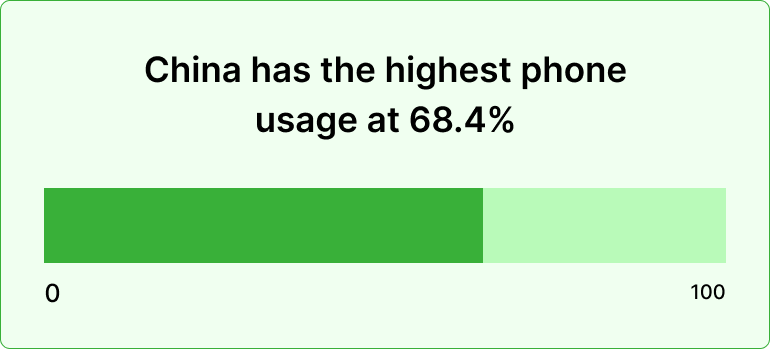The complete monitoring experience for your phone
Get XNSPY and start tracking calls, texts, multimedia, locations and more on any phone!
Get Started Now Live DemoOur screentime is at an all-time high. Whether it is scrolling through social media or binge-watching videos, smartphones have gone from useful gadgets to something we can’t seem to put down.
As a result, a growing number of people are struggling with phone addiction, and many don’t even realize it is happening.
To give you a clearer picture of how deep this issue runs, we have gathered 90 eye-opening statistics. These cover everything from rising usage habits to the impact on mental health, plus a few practical ways you can take back control.
Why Are People Addicted to Their Phones?
People are addicted to their phones because they trigger the brain’s reward system by releasing dopamine, especially through social media, notifications, and instant messaging. This creates a habit loop where users seek constant stimulation and validation.
Smartphones also offer instant access to entertainment, news, and connection, all of which make them hard to put down. The fear of missing out (FOMO), boredom, and stress further drive people to check their phones repeatedly.
Over time, this leads to compulsive usage, reduced attention span, and dependency. The convenience and emotional comfort smartphones provide make them addictive tools for many.
Don’t Forget to Check Out These Related Blogs
🛑 75+ Cyberbullying Statistics Every Concerned Parent Should Know
💬 Is Telegram Used for Dating? Here’s What Happens Inside Private Groups
⚠️ 17+ Dangerous Social Media Challenges: The Dark Side of Internet
💭 Decoding Snapchat Slang: 150 Terms Parents Need to Know
General Statistics on Phone Addiction

1. 69% of people check their phones within the first 5 minutes of waking up.
2. 71% of people spend more time on their phone than with their romantic partner.
3. Numbers indicate that Gen Z averages 6h 27m, Millennials 5h 28m, Gen X 4h 48m, and Baby Boomers 4h 19m of screentime.
4. 60% of all global website traffic comes from mobile devices.
5. 54% would rather spend time on their phone than with their partner.
Important Cell Phone Addiction Statistics

6. 50% of people feel uneasy leaving their phone at home.
7. Smartphone users click, tap, or swipe 2,617 times per day.
8. On average, most users check their phones 352 times daily.
9. 87% of people check their phones within an hour after waking up.
10. Smartphone users unlock their phones 150 times a day.
Cell Phone Addiction Statistics by Age
Stats on Teens

11. Teens who use their devices for more than 5 hours a day are 71% more likely to show suicide risk factors.
12. 52% of children sit silently on their phones even when they are in the presence of friends.
13. 67% of teachers say students are distracted by devices.
14. On average, 33% of teens spend more time online than socializing.
15. Approximately 41% of teens feel overwhelmed by daily text alerts.
Stats on Adults

16. 12% of U.S adults and 7% of British adults use phones in the shower.
17. Approximately 66% of adults experience some level of nomophobia.
18. 75% of adults check their phones while they are in the bathroom.
19. 30% of adults message their partners despite living in the same house.
20. On average, 86% of adults check their phones while in conversation with others.
Phone Addiction Statistics Worldwide
Country-Specific Smartphone Addiction Statistics

21. China has the highest phone usage, followed by India, then the U.S.
22. 44.3% of Koreans said their phone usage increased during COVID-19.
23. In Bangladesh, 61.4% of young adults show signs of smartphone addiction.
24. The Philippines’ daily smartphone usage averages 5 hours and 47 minutes.
25. 58% of college students in India experience nomophobia.
Statistics on Phone Addiction in America

26. 31% of American adults claim that they are “constantly online.”
27. The average American looks at their phone 5 hours and 16 minutes per day (2025), which is up 14% from 2024.
28. About 155 million people in the United States own an iPhone.
29. Approximately 75% of Americans are reported to have texted while driving.
30. Around 55% of Americans haven’t gone longer than 24 hours without their phone.

What Starts as a Habit Can Become a Trap
Take charge of their screen time by monitoring with XNSPY.
How Many People Are Addicted to Their Phones

31. Almost 40% of all consumers admit to overusing their mobile devices.
32. 47% of parents believe that their child is experiencing a smartphone addiction.
33. 60% of people between the ages of 18-34 admit to similar addictions.
34. Around 9 in 10 smartphone users check their phones before bed.
35. 6.3% of the 3.8 billion smartphone users are believed to be addicted.
Daily Phone Usage Statistics

36. Roughly 66% of people exhibit signs of nomophobia, which is the fear of anxiety of being without their phone.
37. On average, people check their smartphones every 12 minutes throughout the day.
38. American teens send an average of 39 texts per day.
39. Smartphone users send 278% more texts and receive 427% more messages/notifications compared to a decade ago.
40. One in seven adults depends exclusively on their smartphone for internet access.
Post-COVID-19 Cell Phone Addiction Facts

41. 60% of global smartphone users believe they use smartphones excessively post-COVID.
42. Since the pandemic, 48% of adults report spending more time on their smartphones.
43. Social media saw a 61% spike in usage throughout the pandemic.
44. Children’s daily screentime rose by an average of 50 minutes following the pandemic.
45. The pandemic drove a 45% increase in online shopping, contributing to more time spent on mobile devices.
Mobile Phone Usage Statistics by Gender

46. Addiction statistics are marginally higher in males at 30.3%, compared to 29.3% in females.
47. Surveys report that 75% of women feel that their partner uses their phone too much during leisure time spent together.
48. On average, females use smartphones for 166.78 minutes per day, while males spend 154.26 minutes on their devices daily.
49. Women who spend more than 4 hours a day on screens face a threefold increase in depression risk.
50. In low- and middle-income countries, 67% of men own a smartphone compared to 55% of women.
The After-effects of People on Their Phones

51. 21% of teens say they feel more comfortable texting than talking in person, highlighting the decline of social interactions.
52. 42% of users say they waste “too much time” on their phones, often at the expense of sleep, hobbies, or in-person interaction.
53. 30% of individuals report feeling isolated or lonely despite constant digital connectivity, indicating that online communication may not fulfill emotional needs.
54. 28% of individuals report that excessive phone use has hurt their productivity at work or school.
55. As a sign of growing phone addiction, 47% of people say they feel mentally exhausted after long scrolling sessions, particularly on social media.
Why People Are Becoming Phone Addicts

56. 60% of adults say they use their phones to avoid social interactions in uncomfortable or awkward situations.
57. 62% of people admit they open social media apps without a specific purpose, driven by habit or boredom.
58. 89% of phone addicts say receiving notifications triggers a dopamine response, making them want to check their phones immediately.
59. 54% of people say they feel “left out” or fear missing out (FOMO) if they don’t check social media regularly.
60. 35% of people say smartphone use fills emotional voids, such as loneliness or stress, reinforcing dependency.

Break the Scroll Habit with XNSPY
Manage your phone use before it starts managing you.
Facts About Phone Addiction Signs

61. 58% of users feel restless or irritable when they can’t access their phone for an hour.
62. 46% of people have tried to reduce their screen time but relapsed within 3 days.
63. 37% of people say they use their phone for over 5 hours a day, often without realizing it, which is a key indicator of compulsive use.
64. One in three people admit to lying about their phone usage, which showcases feelings of denial or embarrassment.
65. 29% of smartphone users confess to losing sleep because they couldn’t stop scrolling on their phone.
Problems Caused by Smartphone Addiction
Physical Health Problems

66. 70% of U.S adults report suffering from digital eye strain.
67. 34% of people experience neck or back pain due to excessive smartphone use.
68. 67% of frequent smartphone users aged 18-35 are affected by text neck syndrome due to prolonged downward head tilt while using the phone.
69. Approximately 35% of teenagers report frequent headaches associated with prolonged phone use.
70. Poor posture from smartphone use contributes to spinal misalignment in 48% of college students.
Mental Health Problems

71. Almost 50% of American adults experience anxiety without their phones.
72. 69% of smartphone addicts report poor sleep quality as compared to 57% of non-addicts.
73. Approximately 30% of college students exhibit problematic smartphone use, which has been linked to increased rates of insomnia.
74. Spending more than 5 hours per day on screens is associated with a 43% higher risk of experiencing depressive symptoms.
75. Around 37% of people report feeling lonely, insecure, disconnected, or even lost when they are without their phones.
Cybersecurity Problems

76. 82% of phishing sites now target mobile users.
77. 66% of U.S adults have received messages from unknown individuals via social media.
78. 33.3 million mobile malware/ adware attacks occurred globally last year.
79. 23% of mobile malware targets productivity apps such as VPNs and PDF tools.
80. Riskware and Trojans account for approximately 80% of mobile threats.
Road Safety Problems

81. Phone distractions were a major factor in 21% of fatal teen driver accidents.
82. In 2010, cell phones caused 1.1 million car crashes, including 160,000 texting-related crashes.
83. Texting while driving increases the risk of a crash by 23 times.
84. Each year, 1.6 million car accidents are caused by phone use, including texting and talking.
85. 390,000 car crashes per year cause severe injuries due to phone-related distractions.
Phone Addiction Facts: Uncovering the Root Causes

86. 56% of users admit to checking their phones out of habit, even when there’s no notification, a sign of compulsive behavior development.
87. 47% of users in low-income households rely on smartphones as their primary source of internet, increasing dependency due to a lack of alternatives.
88. Dark design patterns, such as infinite scroll and auto-play features, can increase time spent on a device by up to 35%.
89. 28% of people earning less than $30,000 per year are smartphone-dependent, meaning they lack home broadband and rely solely on mobile access.
90. As many as 45% of users report relying on their phones as their primary way of coping with negative emotions.
4 Proven Methods to Prevent Phone Addiction
Considering the statistics discussed above, it is evident that mobile phone addiction is a growing concern, significantly impacting mental health and overall daily functioning.
In particular, the constant urge to check notifications or scroll endlessly has become a common and often overlooked compulsion.
As a result, to address this issue effectively, we have compiled four practical steps that can help prevent mobile phone addiction and support healthier screen habits.
1. Use XNSPY
XNSPY is a powerful phone monitoring app designed to track and manage your child’s screen time and phone usage. With real-time insights into screen time, parents can easily identify patterns of phone and social media addiction and respond proactively by remotely blocking apps or locking the device.
Therefore, these detailed actuarial reports of their device usage help detect early signs of phone addiction.
Moreover, by monitoring their SIM activity, social media, internet history, etc., XNSPY enables parents to better understand their child’s digital habits. This, in turn, allows for timely intervention, whether through counseling or other support, to address potential dependency issues.
2. Practice Mindfulness
One effective approach to overcoming mobile phone addiction is through the practice of mindfulness. By teaching your child to be present in the moment, you can develop a deeper awareness of phone usage and its effect on the well-being of your loved ones.
By adopting regular mindfulness activities, such as meditation, you can help them identify triggers for excessive phone use.
3. Set Limits for Usage
Setting limits for mobile phone usage is a practical strategy to combat addiction. By establishing specific time frames for phone use, individuals can create a sense of structure and control over the digital habits of their loved ones.
For instance, setting app usage timers or designating phone-free periods during meals or before bed can help reduce unnecessary screen time.
An approach like this not only limits distractions but also promotes a balance between the virtual world and real-life activities.
4. Reduce Notifications
Another key strategy in managing mobile phone addiction is to reduce notifications. Such constant alerts often create a sense of urgency, prompting frequent phone checks and contributing to increased screen time.
By turning off non-essential notifications on your loved one’s phone, you can decrease distractions and limit the impulse to check their phone. All in all, making adjustments like this can help you stay more focused and present.
Conclusion
The statistics on phone addiction point to an escalating issue that goes beyond age and background. With rising screen time linked to increased stress, anxiety, sleep disturbances, and reduced physical activity, the need for awareness and action is more urgent than ever.
The key to prevention is to first recognize early signs of problematic use, such as constant checking, decreased face-to-face interaction, or mood shifts. To counter the issue eventually, various strategies can be employed, ranging from setting screen time limits to using parental monitoring tools like XNSPY.
Remember, the ultimate goal is not to reject technology but to use it more mindfully.
4 Comments
Leave a reply:
Your email address will not be published. Required fields are marked*




Lauren Bissell
July 30, 2025 at 8:09 amVery fair reasons shared.
Godrictre
August 1, 2025 at 2:40 pmthanks for this informative content
Wednesday Addams
August 11, 2025 at 2:40 pmPlease be aware parents, my daughter got addicted to phone at just 10 years old and has been seeking therapy since. It is a very tough battle but I am willing to educate myself as much as I need to.
Rayan James
August 20, 2025 at 2:33 pmCan you tell me more about the help I can seek if I feel like my teen is addicted to his phone?